For starters, we have listed the eminent factors that you need to consider when choosing the RV inverter for you.
Type: There are mainly three kinds of inverters that are suitable for your RV. The first option, a pure sine wave inverter is the ideal which can charge all kinds of appliances with ease and produce less sound too. However, they are expensive. The second one, modified sine wave inverters are the ones that can be used for bilk electrical appliances. The final option is the square wave inverter which is affordable but can only charge smaller appliances. Watts Capacity: For this factor, you need to consider two factors which are the surge power and the constant power. The surge power is the maximum power that is given by the inverter and the constant power is the power that is consistently given after surge power dies down. It is very important to consider this factor. Power Rating: Another consideration for buying any inverter is the power rating. The power rating for any inverter should ideally be 5,000 watts.
More details on the factors to consider when buying the best inverter for the RV is discussed in the “Buying Guide” given later in the article. In this article, we have listed the best products with their most notable features, advantages, and disadvantages. Read on to know all about them.
Best Inverter for RV Table List
Best Inverter for RV Reviews
1. Ampeak Inverter for RV
With 2000W power, this inverter converts 12V DC to 110V AC supply. It features 3 AC outlets, 2 USB ports, 3 feet battery cables and DC cigarette lighter. It offers the best in class protection with 17 different kinds of protection levels. It extends the life of both the inverter and the electrical appliances charged by them. The temperature of the inverter is controlled with the featured cooling fans. The low interference technology allows quiet functioning of the whole unit. Moreover, the LCD display shows all the working status of the power inverter. This device is compatible with all kinds of electrical appliances. The lightweight design makes it easily portable. Best Features:
Number of Outlets: 3 Voltage: 12 V to 110V Continuous Output: 2000 W
Pros:
17 kinds of protection technology. Low-noise operation. Temperature control. LCD display.
Cons:
People thought that the wiring was not safe.
2. POTEK Inverter for RV
With a surge peak power of 4000W and the continuous power of 2000W, this power inverter can serve charge to several electrical appliances at the same time. There is one USB port and 3 AC outlets that effectively charge the refrigerator, flood lights, freezer. TV and other electrical appliances. Further, the device provides multi-level protection like the overload, over-voltage, overheating, under-current, short circuit and overvoltage protection. The in-built cooling fan maintains the temperature of the inverter while at use. The lightweight and compact design makes the inverter portable. It comes with a user guide and provides customer-friendly service. Best Features:
Number of Outlets: 3 Voltage: 12V to 110V Continuous Output: 2000 W
Pros:
3 AC outlets. Multi-level protection. In-built cooling fan. Lightweight and compact.
Cons:
People had a problem with the durability.
3. Kinverch Inverter for RV
Kinverch has come with a pure sine wave inverter with 2000W of continuous voltage and peak power voltage of 4000W. Also, it has 1 USB port with 3 AC outlets. The AC outlets can handle electrical appliances with sensitive load like medical machine, microwave, fridge, oven, icebox etc without any kind of hassle. It is loaded with 2 cooling fans and 8 internal fuses that ensures safety protection like over and under voltage charging, overloads, short circuiting , overcharging and overloads. Also, the fans dissipate the heat and help in silent operation. This product supports easy functioning and can be controlled by your phone. You can also check the performance on your phone. Best Features:
Number of Outlets: 4 Voltage: 12V to 110V Continuous Output: 2000 W
Pros:
Can handle appliances with sensitive load. 2 cooling fans. Easy functioning. Silent operation.
Cons:
People complained of the bad service.
4. Renogy Inverter for RV
Renogy has come up with a dynamic DC/AC power inverter which delivers 2000W continuous power and a peak surge of 4000W during the startup load. This is a pure sine wave inverter which converts 12V DC to 120V AC supply. With great conversion efficiency, it supports a conversion efficiency of less than 90% during the conversion loss. It features LED indicators that show over voltage, under voltage protection, short circuit indication, overload protection and temperature protection. Additionally, the cooling fans control the temperature and it is very easy to use. This is an ETL approved power inverter which offers one-year workmanship and material warranty. Best Features
Number of Outlets: 3 Voltage: 12V to 120V Continuous Output: 2000 W
Pros:
Less than 90% conversion loss. Cooling fans keep the temperature in control. LED indicators. Easy to use.
Cons:
People thought that the body was made of cheap material.
5. K KRIËGER Inverter for RV
With 2000W continuous power and 4000W peak power, this power inverter transfers the 12V AC to 120V DC supply. You can directly connect it to the 12V battery and charge it at one go. This is an all-inclusive version which features a wired remote control with 3 feet battery cables and an ANL fuse kit. They are top-class when it comes to providing protection of any kind like the overload protection, over voltage protection, under voltage protection,short circuit protection and high-temperature protection. The LCD display shows the output wattage, input voltage, and battery level. It is certified by ETL and the brand offers a 3-year warranty. Best Features:
Number of Outlets: 2 Voltage: 12 V to 110 V Continuous Output: 2000 W
Pros:
All-inclusive inverter. Certified by ETL. 3-year warranty. Features ANL fuse kit.
Cons:
The manual had poor explanation of the points.
6. GIANDEL Inverter for RV
This is a pure sine wave inverter that provides 100% 2200W continuous power and surge power of 4400W. It is suitable to connect it to any 300W electrical appliances. This power inverter connects to a solar panel and has an in-built controller with a selectable switch. The battery voltage indicator clearly shows the battery voltage of the inverter. This controller also allows the use of a solar charge controller and can be used as a separate inverter function. Also, it is easy to use due to the remote operation. It offers full safety protection that also has auto-restart function. The aluminium alloy body makes the product durable and long-lasting. Best Features:
Number of Outlets: 2 Voltage: 12V to 120V Continuous Output: 2200 W
Pros:
100% 2200W continuous power. In-built controller. Selectable switch. Remote control operation.
Cons:
The brand does not honour the warranty period.
7. GoWISE Inverter for RV
This power inverter comes with 3000W continuous power and a surge power of 6000W. It converts 12V DC to 120V AC. This unit consists of red and black cables with ring terminals. It also has 4 output sockets. It is suitable for use in vessels, power failure emergencies and RVs. On top of that, there are five kinds of protection systems like low voltage protection, under voltage protection, over voltage protection, overload protection and thermal protection. The total harmonic distortion is less than 3% and has additional features of temperature control, soft start and low interference tech. It has an output voltage of 120V and frequency of 60 Hz. It is compatible with all kinds of electrical appliances. Best Features:
Number of Outlets: 4 Voltage: 12V to 120V Continuous Output: 5000 W
Pros:
Red and black cables. Compatible with all kinds of electrical appliances. Temperature control. 4 output sockets.
Cons:
People had a problem with the customer service.
8. AIMS Inverter for RV
Aims Power has come up with a 5000W power inverter and has been continuously improving for the last 20 years. It features a AC direct connect terminal with AC output protection over a short circuit. The product also features LED indicators for temperature and overload. Also, the cooling fan helps to thermally control the temperature of the inverter. The unit consists of a remote pre-wired for an on/off switch. It is compact in size and lightweight which makes it a perfect fit for the RV. This device does not need several sets of cables or jumpers for functioning. Best Features:
Number of Outlets: 2 Voltage: 12V to 120V Continuous Output: 5000 W
Pros:
LED indicators. Temperature control. Pre-wired on and off switch. Lightweight and compact.
Cons:
It is not durable enough.
9. Xantrex Inverter for RV
Xantrex has come up with a small and lightweight true sine wave inverter which is effectively designed to provide consistent and clean power for 12V electrical appliances. It is also an affordable option for all the RV owners. This inverter is suitable for multiple small loads, intermittent loads or large single loads for continuous optimal power. The ability of these inverters can power all the appliances in the RV. Also, the in-built digital display provides system information like output power and input voltage. It also features a USB port and double GFCI outlets for simple use of electronics. Additionally, it is compatible with several applications. This product is easy to install and safe to use. All the necessary hardware for installation are included. Best Features:
Number of Outlets: 2 Voltage: 12V to 110V Continuous Output: 2000 W
Pros:
Provides clean and consistent power. Dual GFCI outlet. Compatible with several appliances. Easy to install and safe to use.
Cons:
Some people think that the fan does not stop.
10. WZRELB Inverter for RV
With 3000W continuous charge and 6000W surge power, this is a pure sine wave inverter which is as good as any power backup or grid power as the home power supply. The premium-quality copper induction ensures the inductance of copper and provides true sine wave AC output which saves all the electrical appliances. The large and imported MOSFETs provide dynamic driving capacity. It converts 12V DC to 110V AC, has 60 Hz frequency and has 2 US outlets. Additional features include earth connection for PCB output and board and also consists of intelligent cooling control. The PCB thickness of 2.00 mm enables to increase the load capacity and stronger and greater current flow. It is portable and compact for the RV. Best Features:
Number of Outlets: 2 Voltage: 12V to 110V Continuous Output: 3000W Brand: Wzrelb
Pros:
Premium-quality copper wiring. PCB thickness of 2mm. Intelligent cooling control. Imported mosfets.
Cons:
Some people thought that it was a fire hazard.
Things to Consider When Buying the Best Inverter for Your RV
Choosing the correct RV inverter can be vital in making the trips comfortable. In the following section, we have listed the primary factors that will help you choose the best inverter for the RV, which will supply clean and uninterrupted energy for the RV at all times. This will make your buying process much easier.
1. Type
For any person looking at the inverters for their RVs, the different types need to be an important consideration. We have discussed all of them to give the buyer a clear idea to choose from.
Pure Sine Wave Inverters: This is the most common type of inverter for RVs. It can draw power from the rotating air conditioning machinery and equipment. The name comes from the idea that sine waves are also generated from the same mechanism. The major benefit of this kind is that all appliances can be charged with this inverter, and you can be sure that the appliances are in their prime with this inverter. However, the only drawback is that this is a high-end product and costs a lot. But, the functioning and the operation are worth all the extra money. Modified Sine Wave Inverters: These are useful if you have too many electrical appliances that you need to charge with the inverter. However, they have reduced power and efficiency in both the machinery and the appliances. They need an extra 20% power compared to the pure sine wave inverters due to the less efficiency in performance. So, the lights in the RV can be less bright than before after you start using this inverter. Also, they cause more noise than the former alternative. Square Wave Inverters: This is the most affordable option and they can help to charge simple electrical appliances without any trouble or hassle. The tools that feature universal motors work well with these inverters.
2. Watts Capacity or Inverter Power
This factor decides the size unit of the inverter required for your RV. There are two basic factors that you need to consider when talking about the size unit of the inverter. The first one is the surge or the peak power and the second one is the usual or the typical power. So, the surge power is the power that is there at the beginning of the power supply from the inverter. It usually peaks at the first fifteen minutes when the inverter starts. Some electrical appliances need this starting surge to get charged. Now, the second factor is the continuous rating. This is the average power of the inverter that you can check for figuring the necessary battery capacity. So, when looking at the inverter power, you need to consider both surge load and continuous load.
3. Power Rating
One of the crucial factors when looking at the inverter specifications is the power rating. The power ratings can vary in a wide range and you can expect ratings that start from 50 watts to 50,000 watts. For the RV owners, the maximum power rating to go for is 5,000 watts. With the power rating, it is also important to look at the maximum surge which can be calculated with the power rating in the given amount of time. The capacity or rating of the maximum surge is different for different inverters.
4. Energy Efficiency
Energy efficiency is very important when it comes to selecting the best inverter. This can be the make or break for the product. The efficiency will influence the energy and the power usage of the inverter. You should make sure to go for those products that do not make energy losses in both the inverters and the appliances.
5. Input and Output Voltage of the Inverter
The input and output voltage will enable you to know the appliances that can be run with the inverter and it will also help to select the inverter according to the power supply in your area.
Final Word
With this guide at your disposal, choosing the best inverter for your RV will be like a walk in the park. We have listed all the criteria that you need to know for buying the best inverter for your RV. Therefore, you just need to apply these considerations when buying the faucet. If you still have doubts, you can write to us in the comments section below.
If you are here for the recommendations, we have listed the top three favourites from the list. The first recommendation is Ampeak Inverter for RV. It features 17 kinds of protection system and offers low-noise operation. The second suggestion from the list is POTEK Inverter for RV. It features 3 AC outlets and provides multi-level protection. The third and final product from the list is K KRIËGER Inverter for RV. It can handle electrical appliances with sensitive load. It also offers easy functioning and silent operation.
Comment * Name * Email * Website
Δ



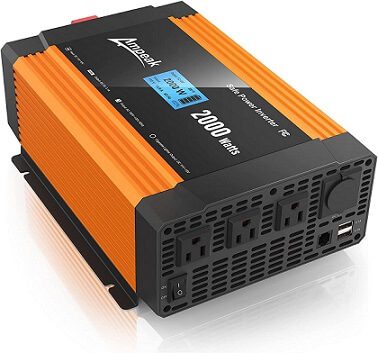
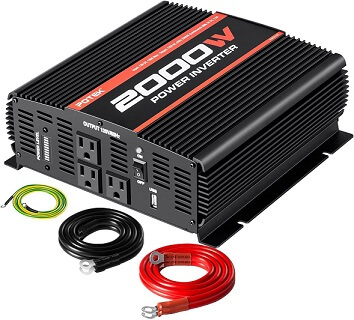

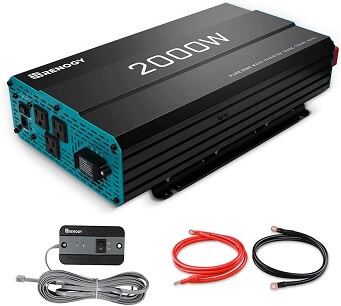
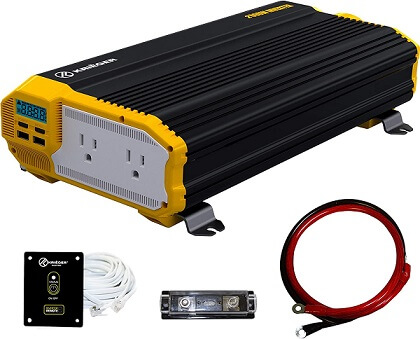

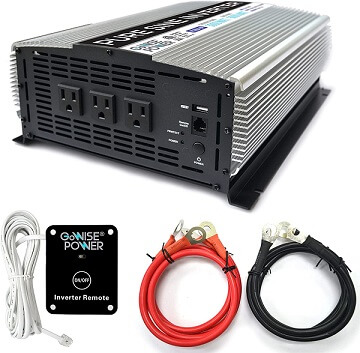





![]()